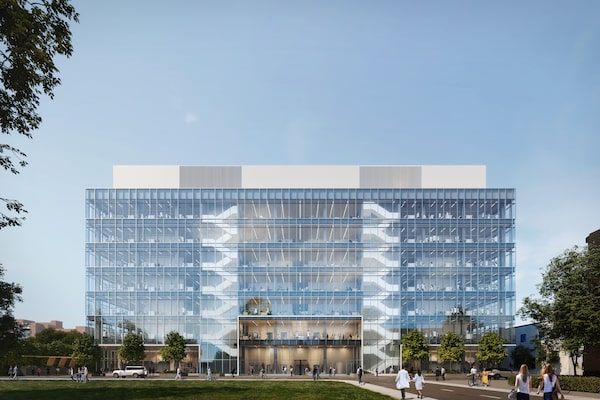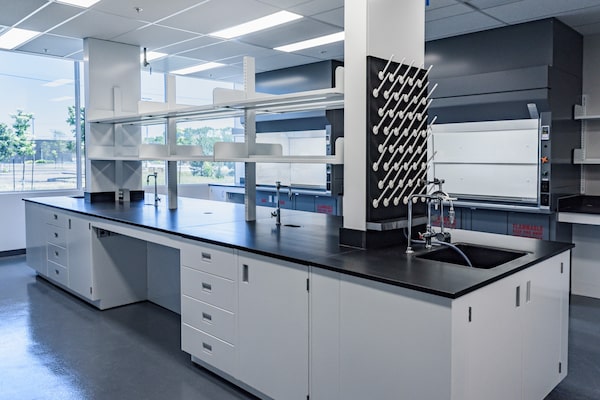
A rendering of Catalyst, a planned research facility located in Toronto’s lower Junction area. The building has 14-foot-high ceilings, stiffened structure and foundation cushioned in rubber to eliminate vibration, and ventilation designed to world-class standards, says the developer.supplied
At a groundbreaking in September for a new seven-storey life sciences laboratory building in Toronto, Cary Solomon, managing partner of Seeker Labs, said the facility is designed to answer an acute need.
“Because there isn’t enough research lab space in the Ontario ecosystem, many Canadian companies who have innovative science and bright futures are forced to move to the United States to commercialize and grow their companies,” he said.
The clear-glass-walled research facility, called Catalyst, is located at 77 Wade Ave., near Lansdowne Avenue and Bloor Street West in Toronto’s lower Junction area. It aims to be a showcase of wet-lab research, with 14-foot-high ceilings, stiffened structure and foundation cushioned in rubber to eliminate vibration, and ventilation designed to world-class standards, Mr. Solomon says. The development is scheduled to be ready for tenants to move in by the first quarter of 2025.
That speedy timeline is an anomaly in the Toronto region, where many biotech lab developments that were proposed in the past two years have stalled, according to a new study by the Ontario Wet Lab Coalition.
Ontario is facing a critical shortage of multitenant type graduation lab space and, while there are 2.7 million square feet in proposed projects, “the earliest occupancy is 2026-27 – if they even proceed,” concluded the coalition of 30 commercial real estate and private and governmental organizations. Ironically, developments are dealing with financing challenges because they’re having trouble finding anchor tenants who will commit to leases for large blocks of space with such long delivery timelines.
The cost of developing wet labs can be three to five times the cost of office projects and developers are reluctant to build without long-term tenant commitments and at least 66 per cent of the building leased, the report noted.
However, the situation is markedly different in Quebec, according to new research by commercial real estate services company CBRE.
There, three developers – HarveyCorp, Jadco Corporation and Alexandria Real Estate Equities – are actively expanding their bio-lab portfolios on spec, says Jeremy Kenemy, senior vice-president at CBRE in Montreal.
“Obviously things are not crazy like they were in 2021, but there’s still a lot of activity,” Mr. Kenemy says. “We are tracking over five million square feet of research lab space and biomanufacturing in Greater Montreal and we’ve determined the total availability of lab space is currently about 3.3 per cent, which is very low.”

A life sciences lab bench requires water, back-up power and high-capacity ventilation.supplied
While the availability of capital is significantly lower than it was in 2021, “there is still a lot of pent-up demand and certain landlords have recognized it,” says Ralf Carcani, Montreal-based associate corporate real estate broker for CBRE.
Significant new Montreal developments announced this year include the Inspire Bio Innovations life sciences centre at the former Montreal Chest Institute in the downtown health corridor. The multiphased project will develop 180,000 square feet of what its creator, Jadco, says is a $350-million investment to create “state-of-the-art laboratories, offices and collaborative spaces.”
Meanwhile, life sciences building specialist HarveyCorp has purchased four office buildings totalling 200,000 square feet in the Cité de la Biotech in Laval, with a plan to convert and expand them to accommodate research labs and create a life sciences campus.
“Each building is about 50,000 square feet and several of them will be expanded, so we are talking over 300,000 square feet of office converted into research labs meeting the needs of both larger, established users and smaller, younger startups,” Mr. Kenemy says. “Many will be prebuilt labs that can be up and running within six months to a year.”
The rents at Inspire Bio Innovations will be higher than the average for lab space in Montreal that is comprised of mostly suburban properties and is currently about $40 a square foot, but they will be less than the average of $80 a square foot in Toronto. Comparable lab space in New York could cost around $110 net in Canadian dollars, he says.
The underlying reason Toronto isn’t seeing similar development speed is perceived risk, says Daniel Lacey, an associate vice-president of the CBRE life sciences team in Toronto. “In Canada, we are reluctant to take risks, unlike our friends in the U.S. who are a lot more risk-tolerant in their investments.” Because of this, Boston and New York have seen significant growth of biotech research space built in recent years.
“Employment in the Canadian sector continues to grow, but capital, while seemingly more abundant than ever before, is being very selective in its investments,” Mr. Lacey adds. As a result of the tightening capital market, overall demand in the life sciences industry across the GTHA has reduced significantly in the past year, according to CBRE’s Toronto Lab Market Fall 2023 report. Demand peaked in 2022 at 3.6 million square feet, while the estimate of active requirements on the market today is just over 1.7 million square feet.
“Everyone is looking for that lead anchor tenant who will sign a lease for 50 per cent or more of the space two years before a project is ready for tenant fit-out,” Mr. Lacey says. “That’s not how R&D tenants work; their funding requires them to get into a space in 18 months or less, otherwise they have to look for an alternative that’s quicker.”
They also need specially equipped physical space. “You just can’t hire somebody in a wet lab research role and have them fire up a lab in their basement or garage and work from home like you can in the office sector,” he notes.
You just can’t hire somebody in a wet lab research role and have them fire up a lab in their basement or garage and work from home like you can in the office sector.
— Daniel Lacey, associate vice-president, life sciences, CBRE Toronto
A few key projects, including 77 Wade, the proposed Leaside Innovation Centre on Toronto’s east side and the newly completed first phase of OmniaBio’s manufacturing facility at the McMaster Innovation Park in Hamilton, will serve as proxies for the Ontario marketplace and its ability to absorb vacancy at market rates, Mr. Lacey says.
The Catalyst building is getting a lot of interest from full-floor tenants, as well as from early-stage teams for what Seeker Labs calls micro suites, ranging from 1,500 to 2,000 square feet, Mr. Solomon says.
“These are laboratories for stepping up from an incubator to a dedicated space with multiple lab benches and an office and lab support area under lock and key for only that company. They can’t share space because they have science that is now commercial or is being supported by backers in the biotech or pharma industries and they can’t share their information.”
And the state-of-the-art building, with its floor to ceiling windows, is also an attraction.
“This is going to be a lovely environment to work in,” Mr. Solomon says. “We have a saying at Seeker Labs that scientists are humans, too, and they like to have beautiful, bright spaces to go to work in every day.”